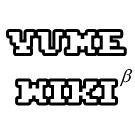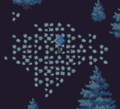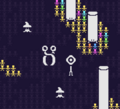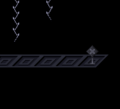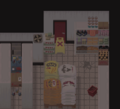m (Grammar) |
(major changes for brevity) |
||
| Line 1: | Line 1: | ||
As an online multiplayer experience, Collective Unconscious places a heavy emphasis on its community. This emphasis not only applies to the community of players playing the game, but also | As an online multiplayer experience, ''Collective Unconscious'' places a heavy emphasis on its community. This emphasis not only applies to the community of players playing the game, but also the growing community of developers and contributors, hence the varied '''content contribution''' methods. The game is entirely given form by the artwork, music, sound, design, and programming that has been provided as a collaborative effort by the authors. | ||
As the game remains in active development, it regularly accepts new content and new contributors. This page provides a general summary of content contribution for ''Collective Unconscious''. '''The information contained on this page, though intended to be accurate, should not be considered fully representative of any of the specific guidelines defined by the development staff. If you decide to contribute, consult the most up-to-date information available on the [https://discord.com/invite/2UmCeFsGvd official development Discord server].''' | |||
== Contributing Content == | ==Contributing Content== | ||
All individuals creating content for the game are ''contributors'', but in most guidelines (as well as on the wiki), ''developers'' are made distinct. Generally, the difference between them is that developers require reservations of RPG Maker data, such as map IDs and variables. | |||
'''Contributors''' | '''Contributors''' are those who submit assets such as music, SFX, pictures, and panoramas. They do not require any prior experience with programming or with RPG Maker 2003. Contributors do not have the ability to implement any assets they create into the game itself; they either submit their work to the game's repository or collaborate with developers that are interested in including their work. | ||
'''Developers''' are given access to the development build and are responsible for detailing and programming maps for the game, as well as initializing assets such as tilesets and animations. The activities that developers are responsible for require ID numbers in the game's database to be reserved in order to avoid conflicts | '''Developers''' are the group of contributors who are given access to the development build and are responsible for detailing and programming maps for the game, as well as initializing assets such as tilesets and animations. The activities that developers are responsible for require ID numbers in the game's database to be reserved in order to avoid merge conflicts. As developers are granted additional privileges and responsibilities, they may undergo greater scrutiny. | ||
Individuals looking to become contributors | Individuals looking to become contributors of any kind must follow the application process that is outlined in more detail in the official development Discord server, linked earlier. This includes filling in a document describing any skills related to the process. | ||
== Content Guidelines == | ==Content Guidelines== | ||
Creative freedom is important for a game like Collective Unconscious, allowing every content contributor to | Creative freedom is important for a game like ''Collective Unconscious'', allowing every content contributor to freely create something meaningful for others to interact with. In the interest of abiding by relevant laws and maintaining a consistent experience for the game at large, however, content is subject to a number of guidelines. | ||
===Usage Rights=== | |||
Everything that is contributed | Everything that is contributed is expected to be the work of the person contributing it, or otherwise be content that the individual has the rights to use. '''Plagiarism of any kind is not acceptable.''' This includes heavy referencing of source material and extreme usage of AI tools. | ||
Contributors and developers are also allowed to restrict how other developers make use of their work, keeping track of individual preferences in a policy document. Developers are expected to have permission from any asset provider they take from. | |||
=== | ===Sensitive Content=== | ||
''Yume Nikki'' and its fangames are known for exploring sensitive topics, and ''Collective Unconscious'' is no different; however, in the interest of catering to a wider range of players, and to maintain a consistent experience, a handful of creative guidelines are enforced. Explicit sexual content, loud "screamer" jumpscares, and depictions of real-world events, public figures, or organizations are strictly forbidden. Depictions of gore, harm, and sexual themes are closely moderated as well. The usage of text, though not itself a sensitive topic, is also closely moderated in the interest of keeping the game as light on text as possible for immersion purposes. | |||
== | ===Quality Control=== | ||
All contributions are subject to a minimum standard of quality control. Quality control guidelines are not intended to punish creators for a perceived lack of artistic ability, instead solely focused on the overall design of each world, emphasizing the creation of maps that are functional and engaging both by themselves and in the context of the game at large. Contributors must be able to analyze their own work critically and consider feedback from others. The maps created for the game are also expected to be in a finished, playable state at the time they are formally submitted. | |||
Collective Unconscious addresses this problem through its '''designated connection''' | ==Designated Connections== | ||
The game's surreal nature allows different dream worlds with little thematic overlap between them to connect, but merely placing a connection anywhere in an existing map can lead to a chaotic and confusing design for the game over time. It also has the potential to disrupt immersion, or violate an author's intent in designing an existing location. In short, new maps must be playable without adversely impacting the locations they are connecting to. | |||
''Collective Unconscious'' addresses this problem through its '''designated connection system.''' When creating a map, developers are encouraged (and oftentimes required, especially for maps of low depth) to proactively designate specific positions for connections by marking them visually with a sign or other object. This informs prospective developers about where their maps are expected to connect, allowing them to design accordingly. | |||
Connections are organised in the ''Connections'' spreadsheet, and new connections are claimed using the ''Open Connections'' form. These documents are once again found in the official Discord server. | |||
There are two types of designated connections: open connections and closed connections. | There are two types of designated connections: open connections and closed connections. | ||
=== Open Connections === | ===Open Connections=== | ||
An '''open connection''' is | An '''open connection''' is one that has no decided connecting area. Other developers are invited to connect their own worlds at this position. The developer that designated the open connection can specify a usage policy if desired, and must always be contacted regardless. | ||
An open connection is denoted by a sign or other prop that is clearly marked with an O symbol. In gameplay, finding an open connection sign indicates that there is no connection present or planned at the moment, but that there may be a connection to another world at this location in the future.<gallery | An open connection is denoted by a sign or other prop that is clearly marked with an O symbol. In gameplay, finding an open connection sign indicates that there is no connection present or planned at the moment, but that there may be a connection to another world at this location in the future. | ||
<gallery> | |||
File:Open Connection Twilight Woods .png|An open connection sign in [[Collective Unconscious:Twilight Woods|Twilight Woods]] in the typical style. | File:Open Connection Twilight Woods .png|An open connection sign in [[Collective Unconscious:Twilight Woods|Twilight Woods]] in the typical style. | ||
File:Open Connection Lilliputian Leaflitter.png|An open connection sign in [[Collective Unconscious:Lilliputian Leaflitter|Lilliputian Leaflitter]] that has been changed to match the style of the world. | File:Open Connection Lilliputian Leaflitter.png|An open connection sign in [[Collective Unconscious:Lilliputian Leaflitter|Lilliputian Leaflitter]] that has been changed to match the style of the world. | ||
</gallery> | </gallery> | ||
=== Closed Connections === | ===Closed Connections=== | ||
When an open connection is taken by a developer, it becomes a '''closed connection''' | When an open connection is taken by a developer, it becomes a '''closed connection.''' A closed connection is no longer available for other developers to utilize, as it has already been claimed. Developers may also use closed connections to indicate they wish to expand their map in a later version. | ||
A closed connection is denoted by a sign or other prop that is clearly marked with an X symbol. In gameplay, finding a closed connection sign indicates that there is no connection present at the moment, | A closed connection is denoted by a sign or other prop that is clearly marked with an X symbol. In gameplay, finding a closed connection sign indicates that although there is no connection present at the moment, one is in active development. | ||
<gallery> | |||
File:Closed Connection Forget-Me-Not.png|A closed connection sign in [[Collective Unconscious:Forget-Me-Not|Forget-Me-Not]] in the typical style. | File:Closed Connection Forget-Me-Not.png|A closed connection sign in [[Collective Unconscious:Forget-Me-Not|Forget-Me-Not]] in the typical style. | ||
File:Closed Connection Mini Mart.png|A unique closed connection sign in [[Collective Unconscious:Mini Mart|Mini Mart]] taking the appearance of a wet floor sign. | File:Closed Connection Mini Mart.png|A unique closed connection sign in [[Collective Unconscious:Mini Mart|Mini Mart]] taking the appearance of a wet floor sign. | ||
</gallery> | </gallery> | ||
[[Category:Collective Unconscious Guides]] | |||
Revision as of 05:45, 15 July 2024
As an online multiplayer experience, Collective Unconscious places a heavy emphasis on its community. This emphasis not only applies to the community of players playing the game, but also the growing community of developers and contributors, hence the varied content contribution methods. The game is entirely given form by the artwork, music, sound, design, and programming that has been provided as a collaborative effort by the authors.
As the game remains in active development, it regularly accepts new content and new contributors. This page provides a general summary of content contribution for Collective Unconscious. The information contained on this page, though intended to be accurate, should not be considered fully representative of any of the specific guidelines defined by the development staff. If you decide to contribute, consult the most up-to-date information available on the official development Discord server.
Contributing Content
All individuals creating content for the game are contributors, but in most guidelines (as well as on the wiki), developers are made distinct. Generally, the difference between them is that developers require reservations of RPG Maker data, such as map IDs and variables.
Contributors are those who submit assets such as music, SFX, pictures, and panoramas. They do not require any prior experience with programming or with RPG Maker 2003. Contributors do not have the ability to implement any assets they create into the game itself; they either submit their work to the game's repository or collaborate with developers that are interested in including their work.
Developers are the group of contributors who are given access to the development build and are responsible for detailing and programming maps for the game, as well as initializing assets such as tilesets and animations. The activities that developers are responsible for require ID numbers in the game's database to be reserved in order to avoid merge conflicts. As developers are granted additional privileges and responsibilities, they may undergo greater scrutiny.
Individuals looking to become contributors of any kind must follow the application process that is outlined in more detail in the official development Discord server, linked earlier. This includes filling in a document describing any skills related to the process.
Content Guidelines
Creative freedom is important for a game like Collective Unconscious, allowing every content contributor to freely create something meaningful for others to interact with. In the interest of abiding by relevant laws and maintaining a consistent experience for the game at large, however, content is subject to a number of guidelines.
Usage Rights
Everything that is contributed is expected to be the work of the person contributing it, or otherwise be content that the individual has the rights to use. Plagiarism of any kind is not acceptable. This includes heavy referencing of source material and extreme usage of AI tools.
Contributors and developers are also allowed to restrict how other developers make use of their work, keeping track of individual preferences in a policy document. Developers are expected to have permission from any asset provider they take from.
Sensitive Content
Yume Nikki and its fangames are known for exploring sensitive topics, and Collective Unconscious is no different; however, in the interest of catering to a wider range of players, and to maintain a consistent experience, a handful of creative guidelines are enforced. Explicit sexual content, loud "screamer" jumpscares, and depictions of real-world events, public figures, or organizations are strictly forbidden. Depictions of gore, harm, and sexual themes are closely moderated as well. The usage of text, though not itself a sensitive topic, is also closely moderated in the interest of keeping the game as light on text as possible for immersion purposes.
Quality Control
All contributions are subject to a minimum standard of quality control. Quality control guidelines are not intended to punish creators for a perceived lack of artistic ability, instead solely focused on the overall design of each world, emphasizing the creation of maps that are functional and engaging both by themselves and in the context of the game at large. Contributors must be able to analyze their own work critically and consider feedback from others. The maps created for the game are also expected to be in a finished, playable state at the time they are formally submitted.
Designated Connections
The game's surreal nature allows different dream worlds with little thematic overlap between them to connect, but merely placing a connection anywhere in an existing map can lead to a chaotic and confusing design for the game over time. It also has the potential to disrupt immersion, or violate an author's intent in designing an existing location. In short, new maps must be playable without adversely impacting the locations they are connecting to.
Collective Unconscious addresses this problem through its designated connection system. When creating a map, developers are encouraged (and oftentimes required, especially for maps of low depth) to proactively designate specific positions for connections by marking them visually with a sign or other object. This informs prospective developers about where their maps are expected to connect, allowing them to design accordingly.
Connections are organised in the Connections spreadsheet, and new connections are claimed using the Open Connections form. These documents are once again found in the official Discord server.
There are two types of designated connections: open connections and closed connections.
Open Connections
An open connection is one that has no decided connecting area. Other developers are invited to connect their own worlds at this position. The developer that designated the open connection can specify a usage policy if desired, and must always be contacted regardless.
An open connection is denoted by a sign or other prop that is clearly marked with an O symbol. In gameplay, finding an open connection sign indicates that there is no connection present or planned at the moment, but that there may be a connection to another world at this location in the future.
An open connection sign in Twilight Woods in the typical style.
An open connection sign in Lilliputian Leaflitter that has been changed to match the style of the world.
Closed Connections
When an open connection is taken by a developer, it becomes a closed connection. A closed connection is no longer available for other developers to utilize, as it has already been claimed. Developers may also use closed connections to indicate they wish to expand their map in a later version.
A closed connection is denoted by a sign or other prop that is clearly marked with an X symbol. In gameplay, finding a closed connection sign indicates that although there is no connection present at the moment, one is in active development.
A closed connection sign in Forget-Me-Not in the typical style.
A unique closed connection sign in Mini Mart taking the appearance of a wet floor sign.
